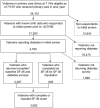Performance of comorbidity, risk adjustment, and functional status measures in expenditure prediction for patients with diabetes
- PMID: 18945927
- PMCID: PMC2606834
- DOI: 10.2337/dc08-1099
Performance of comorbidity, risk adjustment, and functional status measures in expenditure prediction for patients with diabetes
Abstract
Objective: To compare the ability of generic comorbidity and risk adjustment measures, a diabetes-specific measure, and a self-reported functional status measure to explain variation in health care expenditures for individuals with diabetes.
Research design and methods: This study included a retrospective cohort of 3,092 diabetic veterans participating in a multisite trial. Two comorbidity measures, four risk adjusters, a functional status measure, a diabetes complication count, and baseline expenditures were constructed from administrative and survey data. Outpatient, inpatient, and total expenditure models were estimated using ordinary least squares regression. Adjusted R(2) statistics and predictive ratios were compared across measures to assess overall explanatory power and explanatory power of low- and high-cost subgroups.
Results: Administrative data-based risk adjusters performed better than the comorbidity, functional status, and diabetes-specific measures in all expenditure models. The diagnostic cost groups (DCGs) measure had the greatest predictive power overall and for the low- and high-cost subgroups, while the diabetes-specific measure had the lowest predictive power. A model with DCGs and the diabetes-specific measure modestly improved predictive power.
Conclusions: Existing generic measures can be useful for diabetes-specific research and policy applications, but more predictive diabetes-specific measures are needed.
Figures
References
-
- Pogach LM, Tiwari A, Maney M, Rajan M, Miller DR, Aron D: Should mitigating comorbidities be considered in assessing healthcare plan performance in achieving optimal glycemic control? Am J Manag Care 13:133–140, 2007 - PubMed
-
- Joish VN, Malone DC, Wendel C, Draugalis JR, Mohler MJ: Development and validation of a diabetes mellitus severity index: a risk-adjustment tool for predicting health care resource use and costs. Pharmacother 25:676–684, 2005 - PubMed
-
- Meenan RT, Goodman MJ, Fishman PA, Hornbrook MC, O'Keeffe-Rosetti MC, Bachman DJ: Using risk-adjustment models to identify high-cost risks. Med Care 41:1301–1312, 2003 - PubMed
-
- Greenfield S, Sullivan L, Dukes KA, Silliman R, D'Agostino R, Kaplan SH: Development and testing of a new measure of case mix for use in office practice. Med Care 33:AS47–55, 1995 - PubMed


